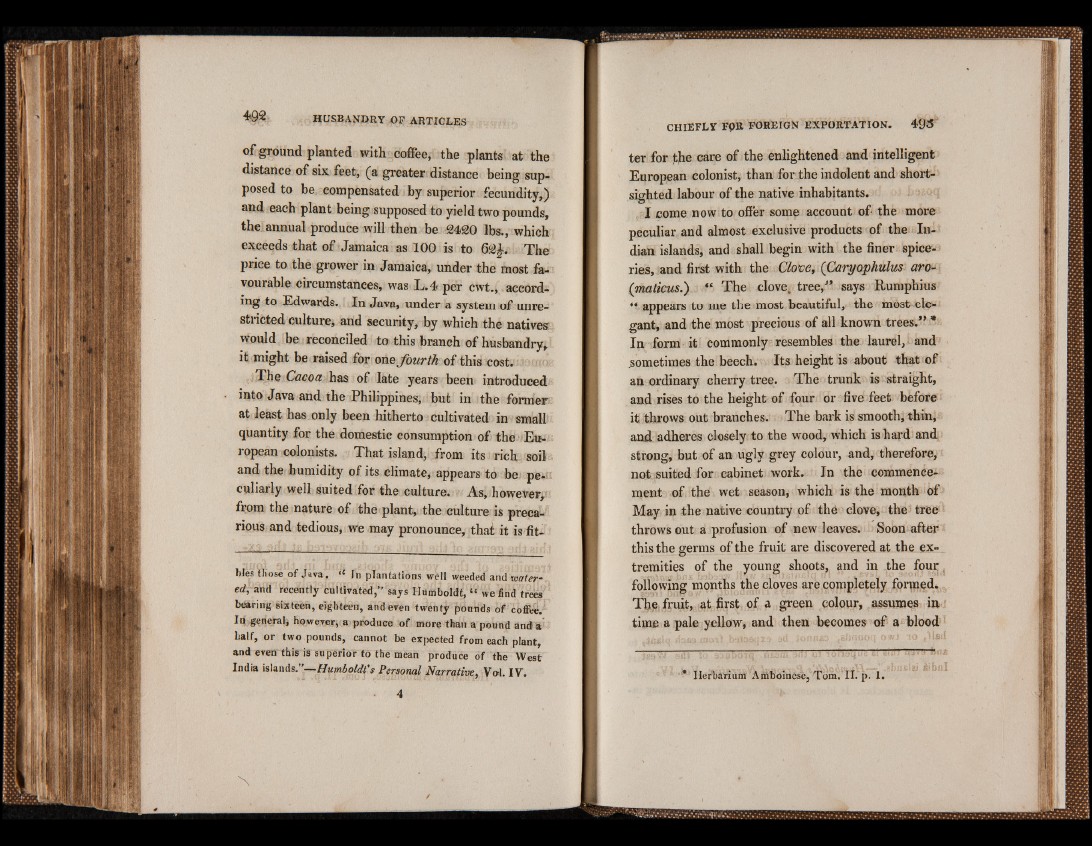
of ground planted with coffee, the plants at the
distance of six feet, (a greater distance being supposed
to be, compensated by superior fecundity,)
and each plant being supposed to yield two pounds,
the annual produce will then be 2420 lbs., which
exceeds that of Jamaica as 100 is to 621. The
price to the grower in Jamaica, under the most favourable
circumstances, was L.4 per cwt., according
to Edwards. In Java, under a system of unrestricted
culture, and security, by which the natives
would be reconciled to this branch of husbandry,
it might be raised for one fourtk of this cost.
The Cacoa has of late years been introduced
into Java and the Philippines, but in the former
at least has only been hitherto cultivated in small
quantity for the domestic consumption of the European
colonists. That island, from its rich soil
and the humidity of its climate, appears to be peculiarly
well suited for the culture. As, however,
from the nature of the plant, the culture is precarious
and tedious, we may pronounce, thaf it is fitbles
tliose of Java, ** in plantations well weeded and water-.
erf, and recently cultivated/’ says Humboldt, “ we find trees
bearing sixteen, eigbteen, and even twenty pounds of coffee.
In general, however, a produce of more than a pound and a
half, or two pounds, cannot be expected from each plant
and even this is superior to the mean produce of the West
India islands.”— Humboldt's Personal Narrative, Vol. IV.
4
/
CHIEFLY F pR FOREIGN EXPORTATION. 4 9 3 *
ter for the care of the enlightened and intelligent
European colonist, than for the indolent and short-
sighted labour of the native inhabitants.
I come now to offer some account of the more
peculiar and almost exclusive products of the Indian
islands, and shall begin with the finer spice-
ries, and first with the Clove, (Caryophulus aro-
(maticus.) “ The clove* tree," says Rumphius
“ appears to me the most beautiful, the most elegant,
and the most precious of all known trees." *
In form it commonly resembles the laurel, and
sometimes the beech. Its height is about that of
an ordinary cherry tree. The trunk is straight,
and rises to the height of four or five feet before
it throws out branches. The bark is smooth, thin,
and adheres closely to the wood, which is hard and
strong, but of an ugly grey colour, and, therefore,
not suited for cabinet work. In the commencement
of the wet season, which is the month of
May in the native country of thé clove, the tree
throws out a profusion of new leaves. Soon after
this the germs of the fruit are discovered at the extremities
of the young shoots, and in the four
following months the cloves are completely formed.
The fruit, at first of a green colour, assumes in
time a pale yellow, and then becomes of a blood
■ Herbarium Amboincsc, Tom. II. p. 1 .